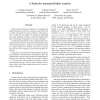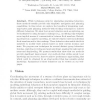70 search results - page 6 / 14 » Using movement and intentions to understand simple events |
ICRA
2005
IEEE
14 years 1 months ago
2005
IEEE
– We describe in detail the behavior of an inhibitory Central Pattern Generator (CPG) network for robot control. A four-neuron, mutual inhibitory network forms the basic coordina...
ICSE
2009
IEEE-ACM
14 years 8 months ago
2009
IEEE-ACM
Classic fault localization techniques can automatically provide information about the suspicious code blocks that are likely responsible for observed failures. This information is...
ICMI
2007
Springer
14 years 1 months ago
2007
Springer
We address the problem of automatic interpretation of nonexaggerated human facial and body behaviours captured in video. We illustrate our approach by three examples. (1) We intro...
SAB
2004
Springer
14 years 22 days ago
2004
Springer
While techniques exist for simulating swarming behaviors, these methods usually provide only simplistic navigation and planning capabilities. In this review, we explore the benefi...
ACL
2003
13 years 8 months ago
2003
Discourse chunking is a simple way to segment dialogues according to how dialogue participants raise topics and negotiate them. This paper explains a method for arranging dialogue...


